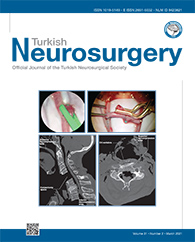2Koc University Hospital, Department of Neurosurgery, Istanbul, Turkey
3Gelisim University, School of Health Sciences, Istanbul, Turkey
4Balikesir University, Medical Faculty, Department of Neurosurgery, Balikesir, Turkey
5Sakarya University Education and Research Hospital, Department of Neurosurgery, Sakarya, Turkey
6Istanbul Research and Training Hospital, Clinical Biochemistry Laboratory, Istanbul, Turkey
7Biruni University, Medical Faculty, Department of Neurosurgery, Istanbul, Turkey
8Istanbul University-Cerrahpasa, Medical Faculty, Department of Neurosurgery, Istanbul, Turkey DOI : 10.5137/1019-5149.JTN.31866-20.2 AIM: To assess and compare the antioxidant capacities of high-grade gliomas (HGG) according to their grades and the presence of isocitrate dehydrogenase 1 (IDH1) mutation using tissue thiol level measurement.
MATERIAL and METHODS: Tissue thiol concentrations were measured in 41 HGG samples and 21 healthy brain tissues obtained from autopsy procedures, which were performed within the first 4 hours of death. All samples were stored at ?80°C, and a thiol quantification kit was used in evaluating tissue thiol levels. The Number Cruncher Statistical System was used for statistical analyses to detect the differences between the control group and the HGG group, which was also divided into subgroups according to their grade and IDH1 mutation presence.
RESULTS: The tissue thiol levels of HGGs were found to be higher than the control group (p=0.001). Although the median thiol levels of Grade 4 gliomas were higher than those of Grade 3, no statistically significant difference was noted (p=0.076). When all tumors were compared according to the IDH1 mutation presence, IDH1-negative (IDH1-) HGGs had higher thiol contents than IDH1 mutant (IDH1+) HGGs (p=0.001). The thiol levels of Grade 4 IDH1- gliomas were statistically significantly higher than of Grade 3 gliomas (p=0.023), but no statistically significant difference between the thiol levels of Grade 3 and Grade 4 IDH1+ tumors was noted (p=0.459).
CONCLUSION: We have demonstrated the higher thiol concentrations of HGGs, particularly IDH1- ones. The sulfhydryl contents of gliomas as an indicator of tumoral antioxidant capacity may be responsible for the treatment resistance of IDH1- gliomas, the mechanism of which is not clear. Thiols can be a novel target for treatment, considering the unsatisfactory results of current modalities for HGGs.
Keywords : High-grade glioma, Glioblastoma, IDH1, Thiol, Antioxidant




